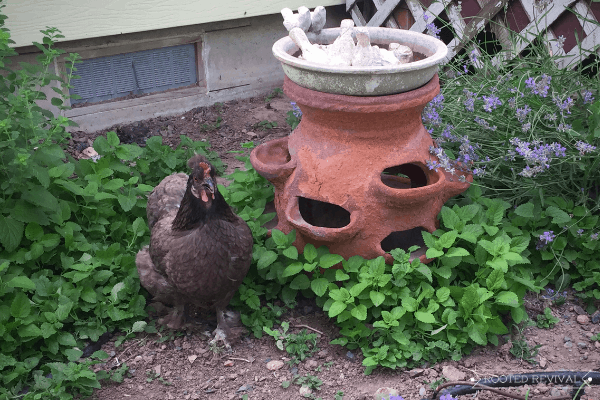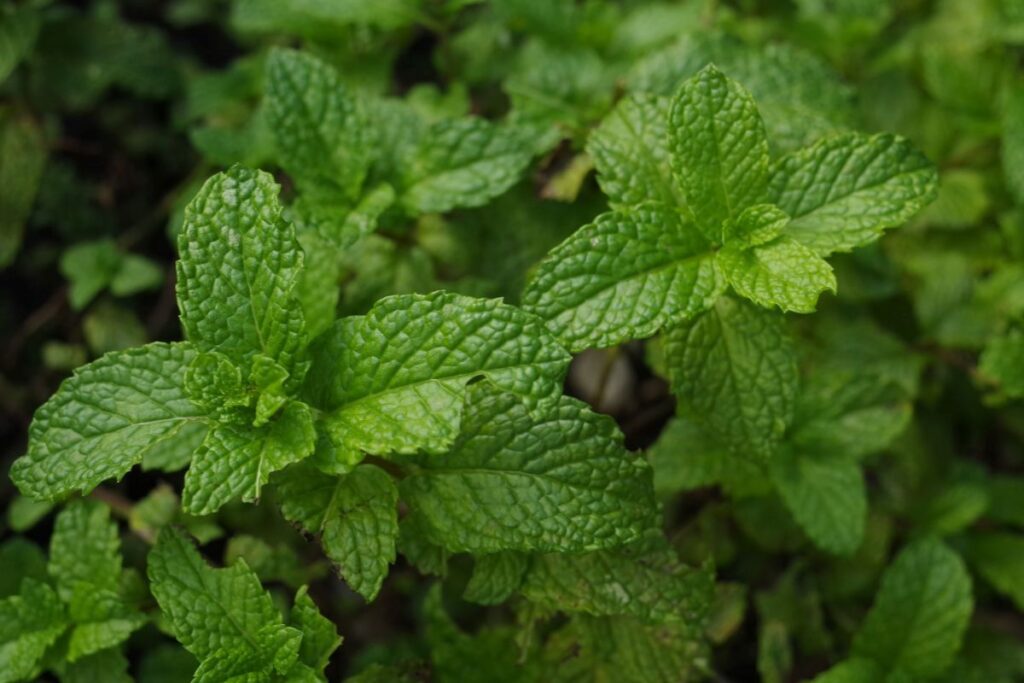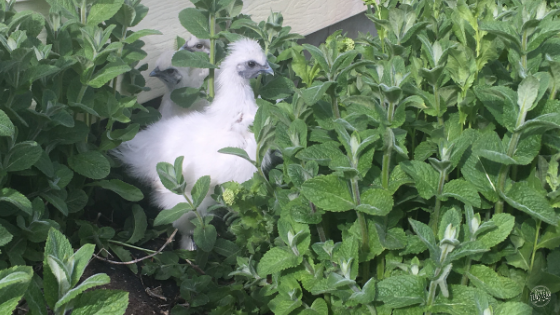Not only is mint one of the most beautiful and aromatic herbs imaginable, but did you know that it is one of the best plants for repelling a range of common bugs? And don’t just take my word for it – there is growing evidence from scientists about this fact too!
Mint is thought to repel to at least some degree the following nine bugs:
- Ants
- Aphids
- Cabbage moths
- Fleas
- Mosquitoes
- Spider mites
- Whiteflies
- Squash bugs
- Cucumber beetles
I’ve been growing (and eating!) mint for many years. In this post, I’ll break down the following:
- How to identify each of the above bugs
- The impact they have on your garden if left unchecked
- How mint is thought to repel them
- Any link to scientific studies to back up these ideas

1. Ants
Identification
We all know ants! They are:
- Small insects! (duh!)
- They have six legs
- Their bodies are divided into three parts – the head, thorax, and abdomen
- They form colonies and visible trails
Impact On Your Garden
Ants can be a real nuisance, and you can never rid yourselves of them completely! They are one of the most populous animals on earth.
Ants nibble at leaves and stems. They create nests that can sometimes disrupt root systems. They can also lead to plant damage.
Weirdly, ants also protect aphids, and they are also a major garden pest.
How Mint Repels Ants
Mint contains a couple of compounds that ants don’t really like. These are:
- Menthol
- Pulegone
Ants find the smell of mint unpleasant. It is thought that it interferes with the pheromone trails that they create, and that are crucial for their navigation. (Source)
2. Aphids
Identification
These are also a real pest in your garden!
Aphids are small and soft-bodied insects. They can actually come in a few different colors, including:
- Green
- Yellow
- Brown
- Black
- Pink
- Even colorless!
They often cluster on plant stems and leaves.
Impact On Your Garden
There are quite a few ways that aphids can do damage to your plants. These include:
- Deforming leaves
- Stunting growth
- Spreading viruses
- Sucking sap from plants (which can cause them to wilt and die)
- Spread plant diseases
So, all in all, a very nasty list!
How Mint Repels Aphids
Mint has two effects on aphids:
Number one, it of course has a powerful aroma, that the aphids dislike. They don’t want to settle on plants around this smell. (Source)
Also, mint actually attracts ladybugs. This is good because they prey on aphids. So as long as you don’t mind ladybugs too much, then this is a pretty good deal.
3. Cabbage Moths
Identification
Cabbage moths are pretty common moths. They are white or light gray.
Their wingspan is about one inch.
The main problem with them is their larvae. These are called cabbage loopers or cabbage worms. They are green caterpillars with white stripes.
Impact On Your Garden
In fairness, the cabbage moths themselves are pretty harmless. Their main impact on your garden is producing pesky cabbage loopers!
These little blighters cause havoc to all cabbages or anything resembling a cabbage.
You know you’ve got them when any cabbage plants have big unsightly holes in their leaves. They can also reduce the overall plant health.
How Mint Reples Cabbage Moths
Once again, the idea here is pretty simple. The strong scent of mint deters cabbage moths, so you see them a lot less in your garden. (Source)

4. Fleas
Identification
Let’s go on to lovely fleas now! Here are the features to look out for:
- They are small, wingless insects
- They have a dark red-brown color
- They have long hind legs and can jump a long distance
Impact On Your Garden
In fairness, fleas offer little problem for your garden plants. Their main annoyance is in biting humans and any pets you might have.
Fleas feed on the blood of mammals. They cause discomfort and can also spread diseases. Getting them out of your garden (as much as possible) is a massive bonus!
How Mint Repels Fleas
There is some evidence that mint plants can deter fleas to at least a minor extent. There is more evidence, however, that mint oil is actually more effective than the plant itself. (Source) Again, it is the aroma of mint that acts as a deterrent.
5. Mosquitoes
Identification
Mosquitoes are probably the biggest pest in the history of mankind. This is what they look like:
- They are small flying insects
- They have slender bodies with long legs
- They have a long proboscis (sucker). They use this to bite and draw blood.
- The females are known for their itchy bite
Impact On Your Garden
Mosquitoes don’t offer any threat to plants. They just bite animals and pets, and so cause discomfort.
They can occasionally transmit diseases as well, for example:
- Malaria
- Dengue fever
How Does Mint Repel Mosquitoes
Mint contains a couple of compounds that mosquitoes do not like. These are:
- Menthol
- Limonene
The strong smell of mint is a natural deterrent to mosquitoes. It is thought that the smell masks the environmental cues (like the smell of humans and animals) for which the mosquitoes are searching. (Source)
6. Spider Mites
Identification
Spider mites are like little tiny pest spiders! Their features include:
- They are tiny, eight-legged creatures
- They can be brown, red, yellow, or green.
- They weave protective silk webs on plant surfaces
How They Impact Your Garden
The main crime they commit is feeding on plant sap. This can cause plants to wither, turn yellow, and even die.
They also leave their webs littered all over the place.
How Mint Repels Spider Mites
Pretty simple again – the strong scent deters them! They quite simply do not like it. (Source)
7. Whiteflies
Identification
Whiteflies are tiny moth-like insects. They are really small, white, and kind of powdery looking.
You usually find them on the underside of leaves. They often fly up in a cloud when you disturb them (not pleasant!).
Impact On Your Garden
These are another pest that suck sap from plants. This causes the following problems:
- Leaves to turn yellow
- Stunted growth
- The transmission of plant viruses
How Mint Repels Whiteflies
Quite simply, whiteflies also don’t like the smell of mint. Planting it as a companion in your garden can hopefully reduce an infestation you might have. (Source)

8. Squash Bugs
Identification
Squash bugs can be identified through the following features:
- They are brown or gray insects
- They have a flat, shield-shaped body
- They often feed on squash plants, such as pumpkins and zucchini
Impact On Your Garden
These are another sap sucker!
They can actually cause a significant amount of damage to any member of the squash plant family. They such all the sap out of them.
This results in:
- Wilting
- Yellowing
- Eventually plant death
How Mint Repels Squash Bugs
You’ve guessed it! Squash beetles don’t like the smell of mint. Simple. (Source)
9. Cucumber Beetles
Identification
- Cucumber beetles are small insects
- They are oblong in shape
- They have yellow-green or black bodies
- They love to feed on any member of the cucumber family, so think cucumbers, melons, and squash
Impact On Your Garden
If you grow cucumbers, melons or squash, then planting mint makes sense as well.
Cucumber beetles can damage any of those plants by feeding on:
- Leaves
- Flowers
- Fruits
How Mint Repels Cucumber Beetles
They don’t like the smell, so they get out of there! (at least to some extent)

